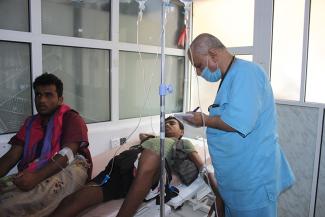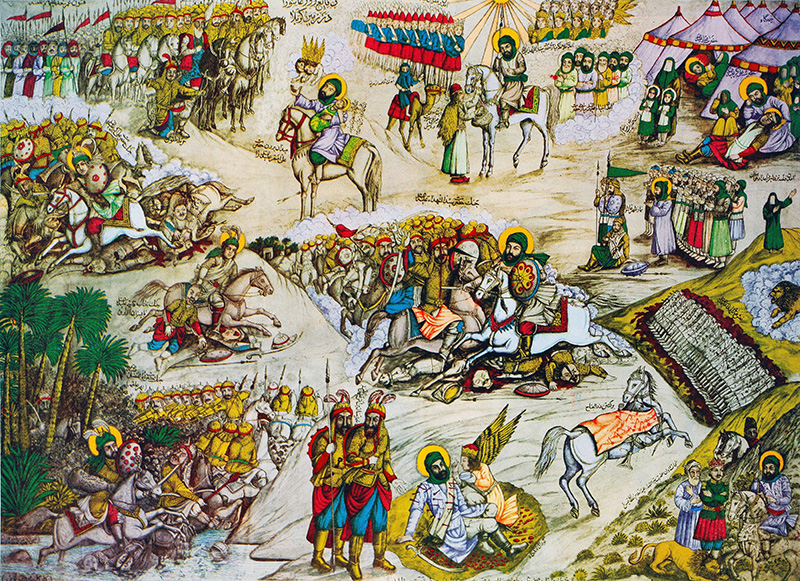Middle East
The sectarian dimension

The rivalry is of a geo-strategic character and concerns who has a greater say over what happens in the region. It is about defining the “rules of the game” and establishing some kind of “balance of power”. The two rival countries are involved in proxy wars in Yemen and Syria. Yemen’s Houthi rebels are backed by Iran and belong to a Shia sect. Bashar al-Assad, Syria’s dictator, belongs to another Shia sect. Militant violence in Iraq similarly reflects Shia-Sunni rivalry.
Quite obviously, the enmity has a religious dimension. The Sunni-Shia schism dates back to the days of Prophet Mohammed (see box). Iran’s Islamic Republic is based on the Twelver Imam strand of Shia Islam. It is ultimately controlled by the clergy. Though President Hassan Rouhani was chosen in popular elections, the Supreme Leader Ayatollah Khamenei, a high-ranking cleric, actually has more power.
Saudi Arabia, on the other hand, is an absolutist monarchy. Its religious doctrine is the Wahhabi version of Sunni Islam. It insists on the literal interpretation of the holy scriptures. Arguing that Mecca and Medina, the holy cities, are in Saudi Arabia, the Wahhabis claim international leadership of the faith.
Problems arise because both sides use their religious beliefs for political purposes. The faith is thus made an instrument of foreign policy. On either side, the leaders pretend to have divine legitimacy for wielding influence, projecting power and enforcing their will.
In January 2016, tensions between Iran and Saudi Arabia came to a head when Riyadh executed Nimr al-Nimr, a cleric who belonged to Saudi Arabia’s marginalised Shia minority. He was accused of having close ties to Iran and promoting “terrorism”.
At the time, 47 people were beheaded or shot. The Saudi government declared them all to be “terrorists”. One of them was Faris al-Zahrani, an al-Qaeda leader. Al-Qaeda, however, is a terror organisation with Wahhabi roots. That Nimr was executed with al-Qaeda convicts was a stark message to Tehran. In the eyes of the Saudi leadership, Iran was cultivating the Shia minority. It showed that it would not tolerate such interference, equating it with al-Qaeda terrorism.
In response, a group of state-affiliated hardliners stormed the Saudi embassy in Tehran and set it on fire. Another radical mob attacked the Saudi consulate in the north-eastern city of Mashhad. This kind of vandalism was widely perceived as retaliation.
In response, Saudi Arabia and its close ally Bahrain severed all diplomatic ties with Iran. Ever since, relations have only strained further, with both sides resorting to indirect methods. Most prominently, the proxy war in Yemen has further escalated. Though the Saudi establishment promised the Houthis would be uprooted “in a matter of days” in May 2017, the war is still being waged.
According to the UN, Yemen is currently suffering the worst human-made disaster.
Numerous attempts at rapprochement and reconciliation by President Rouhani, who is considered a moderate, failed. Saudi Arabia’s strongman Mohammed bin Salman (MbS) has shown no interest in detente. In May 2017, shortly before becoming crown prince, he expressed his deeply sectarian views, ruling out any dialogue with Iran. He stated in an interview that the Shia regime was “built on an extremist ideology” and wanted to “control the Islamic world”.
Extremist ideologies
Saudi Arabia has extremist intentions of controlling the Islamic world too. Its missionaries have a long history of spreading fundamentalist views abroad (also note Blog post by Hans Dembowski on this website). MbS warned in the interview: “We will not wait until the fight is inside Saudi Arabia, and we will work so that the battle is on their side, inside Iran, not in Saudi Arabia.”
In early June 2017, Iran’s parliament and the mausoleum of late Ayatollah Khomeini were targeted in a terrorist assault by ISIS, another terrorist outfit that grew out of Wahhabism and has been disowned by Saudi Arabia. The attack left at least 16 people dead. In September 2018, a military parade in Iran’s southern city of Ahwaz was attacked. Civilians were among the 25 dead. Both ISIS and another Sunni outfit called al-Ahvaziya claimed responsibility. Yet another Sunni militant group is Jaish ul-Adl (Army of Justice), which is active in Iran’s east along the border with Pakistan. In February 2019, a car bomb killed at least 27 members of the Islamic Revolutionary Guards Corps (IRGC).
Iranian authorities have criticised Saudi Arabia and the United Arab Emirates (UAE) for backing militant Sunni groups. There has been violent retaliation as well. The Houthis have used missiles and drones to attack Saudi territory. These arms are widely believed to have been produced with Iran’s technical assistance if not provided directly by Tehran.
In mid-September, drones set fire to Saudi oil-production facilities. Houth forces claimid responsiblity, but Washington and Saudi Arabia blamed Tehran.
Iran has been backing other militias too, for example the Shia Hizbollah in Lebanon. Iran generally does not support Sunni militants, though Hamas in the Gaza Strip is an exception. It is close to the Muslim Brotherhood which is being ostracised by both Egypt and Saudi Arabia. The Muslim Brothers are Sunnis, but do not endorse Wahhabism. While Egypt and Saudi Arabia declare they want peace with Israel, Iran pretends to represent Arab interests in denying Israel’s legitimacy.
US President Donald Trump has prominently taken the side of Saudi Arabia. On his first trip abroad after taking office, he convened an anti-terrorism summit in Riyadh in 2017. Leaders of predominantly Sunni Muslim countries from around the world attended the event. Tehran was declared to be the hub of terrorism, and all parties involved were urged to isolate the Islamic Republic.
Trump’s approach was not successful. Soon after the summit, Qatar decided to maintain its good relationships with Iran. Qatar needs to cooperate with Iran to exploit gas fields in the sea, but is now isolated among the Gulf monarchies. More recently, however, the UAE decided to scale back their military presence in Yemen and seek maritime security negotiations with Tehran.
Trump’s “maximum pressure” policy towards Iran is causing pain in Iran, but so far has not delivered results. Those who have been observing the region know only too well that things were always more complex than his idea of Tehran serving as the hub of terrorism.
Most worrisome, the nuclear deal looks set to collapse. In cooperation with Germany, France, Britain, Russia and China, Trump’s predecessor Barack Obama had lifted economic sanctions in return for Tehran stopping to enrich uranium in ways that would allow it to build nuclear weapons.
Ideological and sectarian differences between Shia-majority Iran and its Sunni nemesis are here to stay. They have the potential of escalating to full-blown war, which would devastate the entire Middle East. Given that Russia and China tend to side with Iran against the USA, the scenario is very dangerous.
The region needs a more peaceful approach. A realistic reconciliation strategy would be for both sides to learn to accept that sectarian differences exist and stop manipulating them for political purposes. At this point in history, that may seem utopian, but it is not impossible. The plain truth is that minority Shia communities have a long history in predominantly Sunni areas, and so have Sunni communities in what is now Iran.
Maysam Behravesh is a senior political analyst at Persis Media and a PhD candidate in political science at Lund University, Sweden.
Twitter: @MaysamBehravesh









